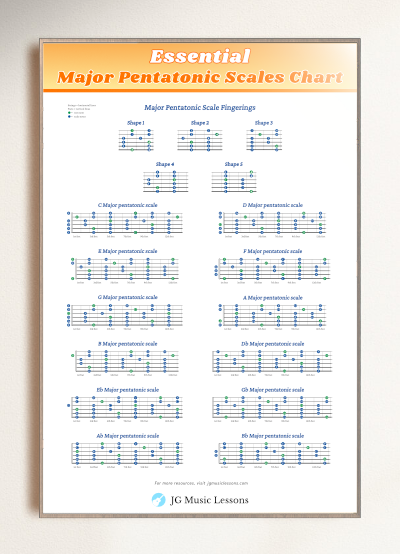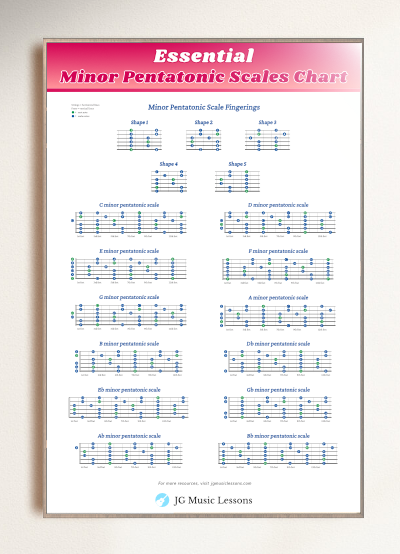The pentatonic scale is one of the most widely used scales in music, showing up in rock, blues, jazz, pop, and more. The word “pentatonic” comes from “penta,” meaning five—because each pentatonic scale contains just five notes.
Learning pentatonic scales is essential for creating melodic, expressive solos and improvising smoothly over chord progressions.
In this lesson, we’ll break down the music theory behind major and minor pentatonic scales, look at the essential scale shapes on the guitar, and explore practical examples with tabs and audio. Let’s dive in!
✨ This PDF is included free with Pro Membership
Major Pentatonic Scale Formula
The Major pentatonic scale consists of five specific notes from the major scale: the 1st (root), 2nd, 3rd, 5th, and 6th scale degrees.. These notes create a bright, open sound that’s easy to use in melodies and solos.
For example, the C Major pentatonic scale includes the notes: C (1), D (2), E (3), G (5), and A (6).

Major Pentatonic Scales Chart (All keys)
The chart below shows the notes that make up the Major pentatonic scale in all 12 keys.
| Major pentatonic scale | 1 | 2 | 3 | 5 | 6 |
| C Major pentatonic scale | C | D | E | G | A |
| D Major pentatonic scale | D | E | F# | A | B |
| E Major pentatonic scale | E | F# | G# | B | C# |
| F Major pentatonic scale | F | G | A | C | D |
| G Major pentatonic scale | G | A | B | D | E |
| A Major pentatonic scale | A | B | C# | E | F# |
| B Major pentatonic scale | B | C# | D# | F# | G# |
| Db Major pentatonic scale | Db | Eb | F | Ab | Bb |
| Eb Major pentatonic scale | Eb | F | G | Bb | C |
| Gb Major pentatonic scale | Gb | Ab | Bb | Db | Eb |
| Ab Major pentatonic scale | Ab | Bb | C | Eb | F |
| Bb Major pentatonic scale | Bb | C | D | F | G |
Minor Pentatonic Scale Formula
The minor pentatonic scale is built from five notes of the natural minor scale: the 1st (root), ♭3rd, 4th, 5th, and ♭7th degrees. This scale has a soulful, bluesy quality that also lends itself well to phrasing, melodic riffs, and solos.
For example, the A minor pentatonic scale includes the notes: A (1), C (♭3), D (4), E (5), and G (♭7).

Did you know that every Major pentatonic scale has a related minor pentatonic scale? If you start a Major pentatonic scale from the 6th degree, you’ll play the same notes as its relative minor pentatonic scale. For example, the C Major pentatonic and A minor pentatonic scales use the same notes.
Minor Pentatonic Scales Chart (All keys)
The chart below shows the notes that make up the minor pentatonic scale in all 12 keys.
| Minor pentatonic scale | 1 | b3 | 4 | 5 | b7 |
|---|---|---|---|---|---|
| C minor pentatonic scale | C | Eb | F | G | Bb |
| D minor pentatonic scale | D | F | G | A | C |
| E minor pentatonic scale | E | G | A | B | D |
| F minor pentatonic scale | F | Ab | Bb | C | Eb |
| G minor pentatonic scale | G | Bb | C | D | F |
| A minor pentatonic scale | A | C | D | E | G |
| B minor pentatonic scale | B | D | E | F# | A |
| Db minor pentatonic scale | Db | E | Gb | Ab | B |
| Eb minor pentatonic scale | Eb | Gb | Ab | Bb | Db |
| Gb minor pentatonic scale | Gb | A | B | Db | E |
| Ab minor pentatonic scale | Ab | B | Db | Eb | Gb |
| Bb minor pentatonic scale | Bb | Db | Eb | F | Ab |
You can also check out this other lesson on how to play minor pentatonic scales on guitar to learn it more in depth.
5 Pentatonic Scale Shapes on Guitar
Now, let’s start learning the 5 pentatonic scale shapes throughout the guitar fretboard.
How to read the scale charts
For the charts below:
- Lowest horizontal line represents the thickest string (Low E) and the top horizontal line represents the thinnest string (high E).
- The green circles represent the root note of the Major pentatonic scale
- Purple notes represent the root note of the minor pentatonic scale
- Blue notes are every other note in between.
- The numbers inside the circles represent the suggested fingering to use on your fretting hand.
(Remember that the Major and minor pentatonic scale the same notes by starting on different scale degrees.)
If needed, check out how to read guitar notation symbols.

Pentatonic Shape 1
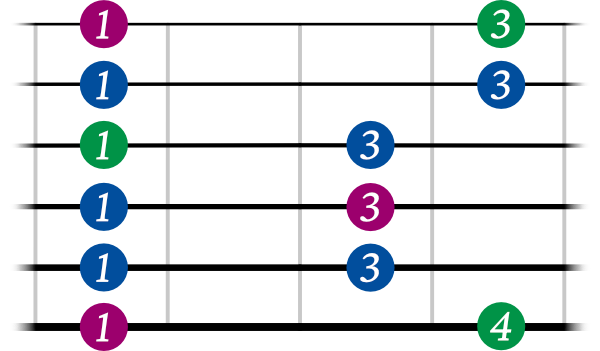
Pentatonic Shape 2
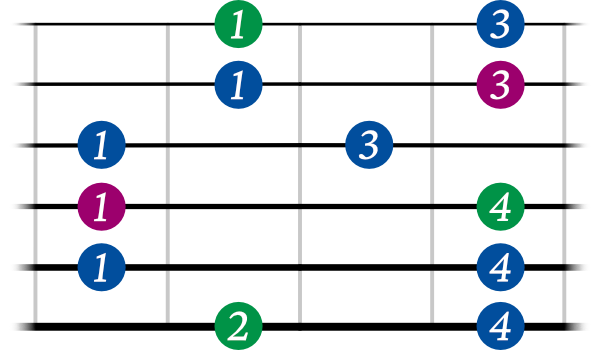
Pentatonic Shape 3
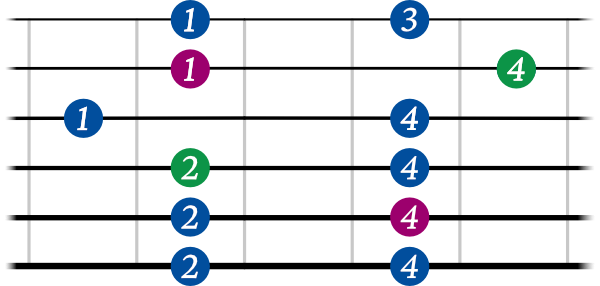
Pentatonic Shape 4
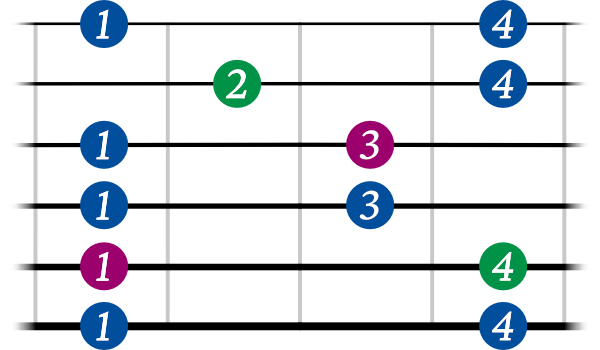
Pentatonic Shape 5
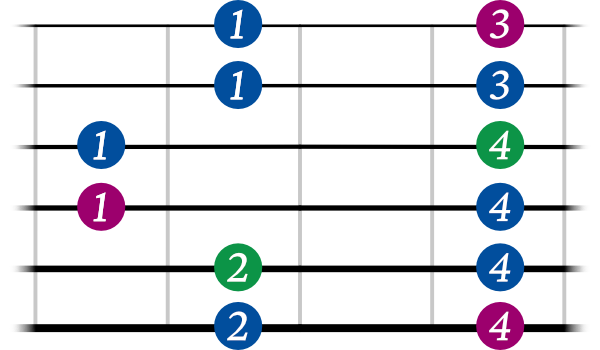
One thing to keep in mind when using these scale shapes is that open strings will require some finger adjustments. For example, if a shape uses the fingering 1, 3, and 4 on a string, you can substitute it with open, 1, and 3 instead.
While you may need to modify certain fingerings when using open strings, the original shapes will return once you move to a position where all the notes are fretted again.
Connecting Pentatonic Scale Shape Examples
Keep in mind that the following shapes can be shifted to any root note, as long as they fit within the fretboard for the scale you’re playing. Be sure to adjust for open strings when necessary.
Connecting shape 1

Connecting shape 2

All the Pentatonic Scale Shapes on Guitar
Below is a visual of how all the pentatonic scale shapes connect across the guitar fretboard. Shapes 1 and 2 show different visual patterns for the same set of notes. You can use these shapes starting from any root note—just shift them up or down the neck as needed.
Shape 1

Shape 2

Pentatonic scale musical application examples
Example 1
This first example outlines all the notes from shape 5, played over a chord progression written above the staff. It’s designed to help you work on technique, memorization, and developing your ear by hearing the scale notes over a series of 7th chords. You can use this same approach to review any of the pentatonic scale shapes.
🔒 This section is for Pro Members only
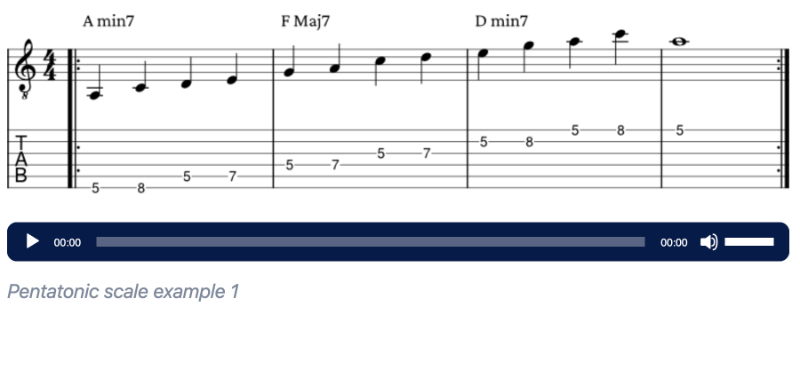
✨ This PDF is included free with Pro Membership
3 Tips for Memorizing the Pentatonic scale shapes
1. Master one shape at a time
Start by focusing on a single pentatonic shape—ideally, the one that feels most natural to you. Practice it until you can play it confidently without needing to look at a chart. Once it’s familiar, use it as a reference point to connect and learn the surrounding scale shapes on the fretboard.
2. Look for repeating fingering patterns
Pay attention to which strings share the same fingerings within a shape. Recognizing these patterns can make memorization much easier.
Quick tip: The 1st and 6th strings always contain the same notes and will have the same fingering.
For example, in Shape 3:
- The 1st, 2nd, and 6th strings all use fingers 1 and 4.
- The 4th and 5th strings follow a 1, 3, and 4 pattern.
- The 3rd string uses a 1 and 3 pattern.
Noticing these repeated fingerings helps you build a mental map of each scale shape more effectively.
3. Connect shapes around the ones you learned
Once you’ve mastered one shape, start learning the shape that comes just before or after it on the fretboard. This helps you see how the scale connects across positions.
Focus on truly memorizing each new shape and be able to play it without looking at the chart before moving on. Breaking the scale into smaller, manageable sections like this makes the learning process much more approachable.
Why use pentatonic scales?
Pentatonic scales are essentially a simplified version of the Major scale, ideal for creating melodies, riffs, and improvisation. As you learn to play and recognize the notes of a pentatonic scale, you’ll notice a familiar sound that’s deeply rooted in modern, popular music.
With just these 5 notes, you can craft interesting patterns and musical ideas. Additionally, pentatonic scales serve as a great guide for navigating the fretboard, offering simplified versions of both Major and minor scales.
Wrapping up
Learning pentatonic scales is a great way to develop your guitar skills, as it helps you think more melodically while simplifying how you approach scales.
The cool part is that once you learn the Major pentatonic scale, you’ve also learned the minor pentatonic—it’s the same set of notes and shapes, just starting from a different point.
Revisit the charts regularly to reinforce the shapes under your fingers. If you need help navigating the fretboard, check out these 7 tips to learn all the notes on the guitar fretboard, which will make playing pentatonic scales much easier.
You might also enjoy exploring the blues scale, which builds on what you’ve learned here.
Hope you enjoyed the lesson and keep having fun with this versatile and expressive scale!
📘 Get the free guitar practice guide here!
All the best,
JG Music Lessons
Reference:
“Penta-.” Merriam-Webster.com Dictionary, Merriam-Webster, https://www.merriam-webster.com/dictionary/penta-.
Start Playing Better, Faster
with Pro Membership! ✨
Get the guidance, tools, and support that keep your progress on track:
🏁 Always know what to practice next. Access the full Guitar Learning Roadmap with lessons in sequence.
🎼 Play songs with confidence. Step-by-step lessons of popular, classical pieces and other styles.
📙 Save time and frustration. Clear PDFs and ebooks that save time so you can focus on playing.
🎟️ Get rewarded for consistency. 2 free downloads every month (a $240+ yearly value).
🎁 Keep costs low while you grow. 50% off all charts, tracks, and posters — up to 75% off bundles.
🚫 Stay focused. Ad-free environment keeps you in the zone.
💬 Get help when you need it. Direct member support to keep you on track.


